vincenzodl
4 posts
Don't wanna be here? Send us removal request.
Text
The Creativity Test
“You can't use up creativity. The more you use, the more you have.” ― Maya Angelou
It was 5 weeks ago where I embarked upon this journey of self discovery and it’s been an absolutely riveting first 5 weeks. Early in the month of October I decided to take up a Creativity Test, and what I came across as I was looking at my results was the fact that I didn’t understand how this was supposed to help me improve. So I set out to take the test again after a month and it was at this point that I realized how different and helpful the results were. 8 factors were taken into account to determine where my creativity score would rank, the factors used are:- 1) Abstraction 2) Connection 3) Persistence 4) Complexity 5) Curiosity 6) Perspective 7) Boldness and 8) Paradox.
Outlining the fact that I got 63.86% for the creativity test proves that I passed the typical score for the creativity test. But what caught my attention is how I lean more towards Complexity as a factor and I felt really positive seeing this as it reflects a part of who I am as an aspiring entrepreneur. The Complexity Factor underlines an individual’s ability to carry large quantities of information, then to manipulate and manage the relationships between such information (TestMyCreativity n.d). To give you a full picture as to how this applies to my entrepreneurial mindset, I’ll set an example. The first group task in our Creativity and Innovation class, we were set with the task to generate a new idea around the concept of 3D Printing.
At that point in time, the most complex aspect that arose was regarding the generation of a new idea around 3D Printing. Each member had so much to say on 3D Printing and it was frustrating to see how we were going around in circles and never coming to a decision, and with limited time I decided to step up and manage the large quantity of information by simply going around the table and noting down each piece of relevant information. As it turned out, it worked. It was less of me manipulating but rather managing the relationship between each member and their ideas. In essence, I acted as a facilitator. This was a completely new and exciting experience that I thoroughly enjoyed, it gave me new insight into some of the daily jobs an entrepreneur performs. But the learning outcome that I took out of this was that patience & tolerance are highly valuable entrepreneurial traits that I still needed work on.
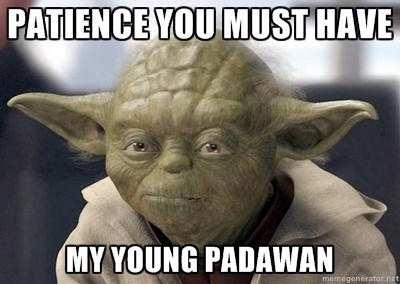
My plan for improvement is to keep a simple diary where I would reflect upon my day and set up action points every day for myself to act upon. With this, it would act as a reminder that results don’t happen overnight and that it is a learning process. Becoming an entrepreneur takes time, effort, patience and experience. The diary won’t just be another book; it would act as a source of inspiration. It would be that book where I look to tick down action points after I’ve completed them, it would be that book where I could write details and details of my feelings, thoughts and emotions. And most importantly, it would be that book that offers a kind of sanctuary for an aspiring entrepreneur to go to in times of need.
List of References: -
TestMyCreativity (n.d) [online] available from http://www.testmycreativity.com/ [31 October 2017]
0 notes
Text
The Contagion Effect of Creativity & Innovation
“Creativity is contagious. Pass it on.”— Albert Einstein
Previously on Creativity & Innovation 101 explored a literature of idea generation & creativity techniques, today let’s take the theory to practice and see how it worked out.
When it comes to solving problems as a group and coming up with ideas we tend to think of the term “brainstorming”, and the focus is to generate as many ideas as possible that are relevant to the topic or question. The success-fullness of this process focuses on making no criticisms, evaluations or judgments during the idea generation process. Hence, creativity is not limited here but rather nurtured (Jossey-Bass et al. 1998:1). Edward De Bono’s book “Six Thinking Hats” acts as a sort of coping mechanism for individuals to regulate the turbulence creative thinking produces. Moving on, I want to showcase how I’ve used these techniques in some real life situations
Its week 1, hit with fresher’s flu and it’s our first creativity and innovation class, and we get the task to come up with a new idea based around 3D printing. I took the initiative to act as facilitator and set the agenda straight. The first task was to clearly define the issue and process in context to the problem at hand and then from there we would assess, evaluate and analyze the process in our discussions.
As facilitator I steered the group’s direction to using our Green Thinking Hats, this would be the system for the group to employ other thinking hats without them even realizing. and suddenly came to existence our new and innovative “Mobile 3D Printing” business, offering both traditional 3D printing services and Mega 3D printing services.
Hence, giving our customers the opportunity to build small and mega structures. What took place was an exchange of ideas regarding market knowledge in specific regions, which by definition set up our target audience. Which then led to how we would generate income as by this stage of the brainstorming process all our ideas culminated into something simple but elegant. It led to this: -
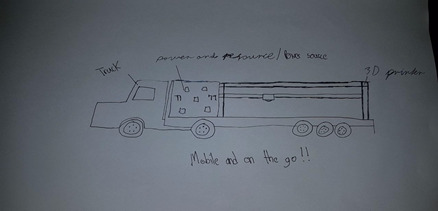
Let’s move to another example. In this case we were given the opportunity to innovate on an existing product which was a coffee cup and after just 10 minutes of discussion we decided to promote the concept of “Self-Heating Cups”. But how and why did we do this? We decided to put on our Thinking Hats and direct our focus to generate an alternative idea to the concept of a coffee cup.
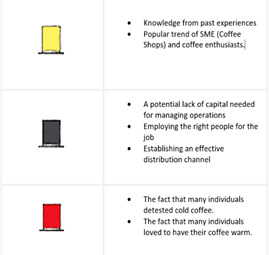
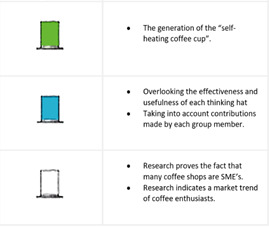
And then we created the sketch concept for our new breakthrough, “The Self-Heating Coffee Cup”
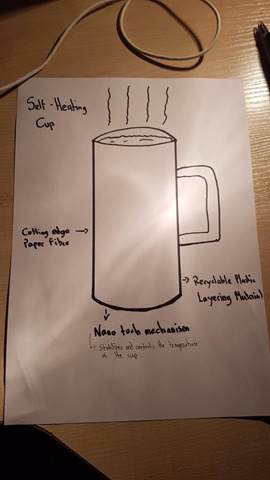
“Knowledge or idea exchange is an important function of groups in organizations” (Paulus & Yang (2000): 76). To conclude, these experiences have allowed me to look past the conventional thought process and venture forward to continuously tap into my creative and innovative capabilities and potential. And it helped in fostering a critical framework that is vital for creativity and innovation.
List of references: -
Gino, Francesca. (2000) ‘Idea Generation in Groups: A Basis for Creativity in Organizations’. Organizational Behaviour and Human Decision Processes [Online] 82 (1), 76-87. available from http://www.uta.edu/cos/paulus/pub/IdeaGeneration.pdf [31 October 2017]
Pfeiffer, J. (1994) The Pfeiffer Library [online] 2nd edn. available from http://home.snu.edu/~jsmith/library/body/v26.pdf [31 Oct 2017]
Quotes About Creativity, Imagination, and Innovation (n.d) KEEPINSPIRING.ME [Online] available from http://www.keepinspiring.me/quotes-about-creativity-imagination-and-innovation/ [31 October 2017]
0 notes
Text
Creativity & Innovation 101
“To raise new questions, new possibilities, to regard old problems from a new angle, requires creative imagination and marks real advance in science.” - Albert Einstein
Creativity is a form of expression that inhibits how one’s imagination can create/transform/develop/solve novel ideas, these creative processes enable oneself to innovate/invent/inspire new and bold ideas. As Mclean (2005) observed, without creative ideas, innovation would just be an engine without any fuel and creativity is needed throughout the process of innovation.
What comes in mind when you think about a coffee cup? Of course the answer is a warm cup of coffee to start off your dreary Monday. Most people want that, and the dream for coffee-lovers is for their coffee to stay warm the whole day. And I know what you are thinking, that is what tumblers and coffee mugs do. They keep your tea and coffee warm for at-least a few hours and they are your source of energy when you’re sleepy on a Monday morning at work. But what if I told you that Tumblers and coffee mugs were obsolete, and that self- heating coffee cups were the next big thing being sold at a Costa near you. That would be extraordinary, right? Imagine not having to buy or carry Tumblers to work, but rather, have a coffee cup that’s light in weight that can withstand the cold winter breeze and occasional rain in England.
Best part is that you could have the choice of disposing the cup for recycling or keep it as your own, yes a cup of coffee would cost a bit more but gone are the days where coffee runs cold after a few hours. And in comes a possible solution to your Monday blues. Sadly, this has not been produced or has their been any news on such an idea. Why, that’s because myself, along with my classmates, came up with this idea. I know what you might be thinking, what a let down it must have been reading the post this far and having your hopes crushed. But in all seriousness, there are always solutions/improvements to every situation/problem. And what we did as a group was that we focused on brainstorming and generating ideas as a unit and jotting them down then coming back as a unit to gather, evaluate and synthesize the best possible solution from all our contributions.
In essence, we fostered the mindset of building on each others ideas (Osborn, 1957). We all paid attention and kept an open mind and ear to each others ideas, and I can definitely say we generated a whole lot of ideas in just a short amount of time. Improvements can still be made, we could look upon minimizing social loafing/free-riding (Karau & Williams, 1993; Kerr and Bruun, 1983) as one of the group members had barely spoken a word and that had most likely happened due to all of us being very vocal and loud in our discussions. As a result, production blocking (Diehl & Strobe, 1991; Lamm & Trommsdorff, 1973) transpired and I feel this is what limited us in the execution of a clear presentation.
As a group, we could perhaps look at different approaches into brainstorming i.e; the Nominal Group Technique (Van de Ven & Delbeco, 1974) that involves initial sessions of independent writing of ideas that the group afterwards shares in a round-robin fashion and is summarized on a blackboard. Then, discussion and evaluation among the group takes place in result to a clarification of the ideas. And, finally the ideas are ranked from best to worst by an individual voting process (Paulus & Yang (2000) ‘Idea Generation in Groups: A Basis for Creativity in Organizations’. Organizational Behaviour and Human Decision Processes Vol. 82, 78 - 79). This could have probably increased our chance to have a more coherent presentation, but at the end of the spectrum this method of brainstorming could have also limited us in my opinion. The aspect we should gauge our attention upon is the possibility of biased responses during the voting process, i.e; each member may end up voting for their own ideas, and hence resulting in possible production blocking, evaluation apprehension and free-riding.
Or maybe the creative thinking tool of SCAMPER suggested by (Bob Eberlen n.d). SCAMPER is a tool that nurtures and values idea generation and creativity by making it a tool to explore possible solutions to a problem. The idea could either be into creating something new or developing an existing product or service (i.e coffee cup), we can Substitute, Combine, Adapt, Modify, Put to another use, Eliminate or Reverse an existing concept and in the process create a much more developed concept. But as always, brainstorming techniques have their setbacks.
In this context, a major drawback of the SCAMPER method is that its effectiveness is limited to companies that encourage free-form thinking [Hanks, Gerald (2017) ‘ What Are the Strengths & Weaknesses of SCAMPER?’ Bizfluent available from https://bizfluent.com/list-7416939-strengths-weaknesses-scamper-.html (Sep 26 2017)]. In the worst case scenario even though SCAMPER encourages groups to think ‘outside-the-box’, this open door concept of brainstorming could result in creating a separation among the group who will favor for one set of ideas over another. And hence leading to absolutely no discussion over the most viable and sound solution to the problem.
To conclude, regardless of what brainstorming technique or creativity tool an individual/group would use in relation to the above situation. Personally speaking, each of these techniques and tools offer a range of processes and ways that can help develop and spark the creative, linguistic, and holistic side of a person but only to a certain extent as there will always be limitations/drawbacks/setbacks to any theories, practices or studies in the field of creative thinking and innovation. Hence, I personally feel that researchers should thread upon revisiting cognitive theories of group creativity (Brown, Tumeo, Larey & Paulus, 1998; Paulus 2000; Paulus, Larey & Dzindolet, 2000) and recognize how the mentality, attitude and behavioral aspect of an individual’s thinking process plays a great role in determining the creativity and idea generating technique they employ.
References:
Hanks, Gerald. “What Are the Strengths & Weaknesses of SCAMPER?” Bizfluent, Leaf Group , 26 Sept. 2017, bizfluent.com/list-7416939-strengths-weaknesses-scamper-.html.
Paulus, Paul B, and Huei Chuan Yang. “Idea Generation in Groups: A Basis for Creativity in Organizations.” Organizational Behavior and Human Decision Processes, May 2000, pp. 76–87.
“Quotes on CREATIVITY and INNOVATION.” Creativity and Innovation Quotes | LeadingThoughts - LeadershipNow.com, www.leadershipnow.com/creativityquotes.html.
0 notes
Text
Outlining the differences between creativity and innovation
Innovation and creativity, these two concepts have been universally conceived to have a similar definition in nature. But in retrospect, there are various differences that separate these two concepts. Initially at the start of my course as a freshman at Coventry University, if someone were to ask me to define creativity then I would have probably given them this definition; “Creativity is the process whereby imaginative thinking sparks new ideas and ways to do, make or build something. And if someone were to ask me to define innovation then I would have probably told them this definition; “Innovation, something new and cutting edge. Something that hasn’t been seen or made ever before”.
But right after the first Creativity and Innovation class with our lecturer Pete, I was completely in shock to see how little I knew when it came to defining creativity and innovation. But it was that very first group task that Pete had assigned us with that really caught my attention. Myself, Harry and Plumen were set with the task to come up with a new idea based around 3D printing. And what happened, we came up with a new idea. In short, we came up with the idea to build a mega 3D printing machine that could transform the technological industry as it could be applied to building virtually anything you desired. And what I learnt from this is that creativity and innovation may go hand in hand at times, but are far from being completely the exact same in definition and in practice.
Thinking back to the group task, I came up with a newer version to my definition of creativity and innovation. Creativity is whereby an individual is able to assimilate brand new ideas to create something new or by transforming the an outdated concept with an advancement into a completely fresh concept. And innovation would be the creative process of implementing one’s ideas, thoughts and aspirations into something that could be potentially of value to someone or something else. But bear in mind a question? To what extent can the term innovation and creativity be defined?
John G. Young gives us an interesting look into his definition of creativity. In his article “The Journal of creative behavior” published on June of 1985, he talks about we can approach creativity from either a “to make” sense or a “to fulfill” sense. He acknowledges that we can approach creativity one of these two senses. He goes on further to state that we use our imagination to “make up” something new and valuable, thus transforming what is into something better. And to me, I see a great deal of transforming as a learner, and especially as an aspiring entrepreneur in this Entrepreneurship course. Moving on, he termed creativity to also be the paradoxical integration of doing and being. The integration of our logical side with our intuitive side, our left brain with our right, It is all of these and more.
Let us now go back in time and revisit Zahra and Covin’s interpretation on Innovation. They suggested that innovation is widely considered as the life blood of corporate survival and growth. Whilst John Bessant defines innovation as creating value from ideas. From one side, Zahra and Covin’s perspective focused on the business and corporate aspect of innovation while John’s perspective focused on the personal and linguistic aspect of innovation.
To conclude, a simple and clear cut answer would be that there is no limit to what we can define creativity and innovation. What’s best, in my opinion, is to research, gather, synthesize and expand the concept meaning behind the broad definition of creativity and innovation. In short, define creativity and innovation in your own way but to always be an open minded and critical thinker.
0 notes